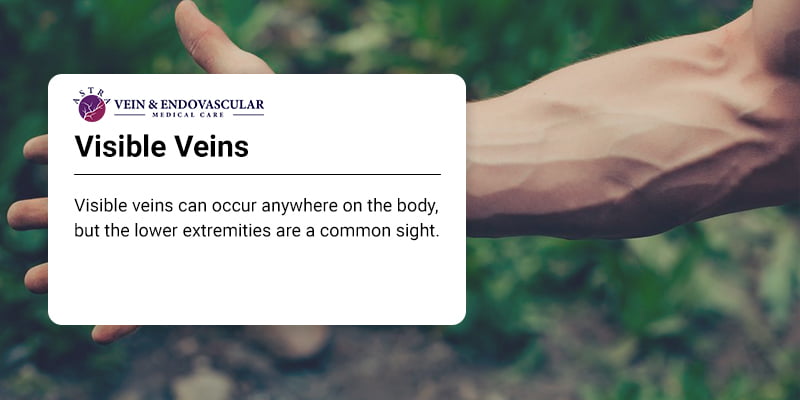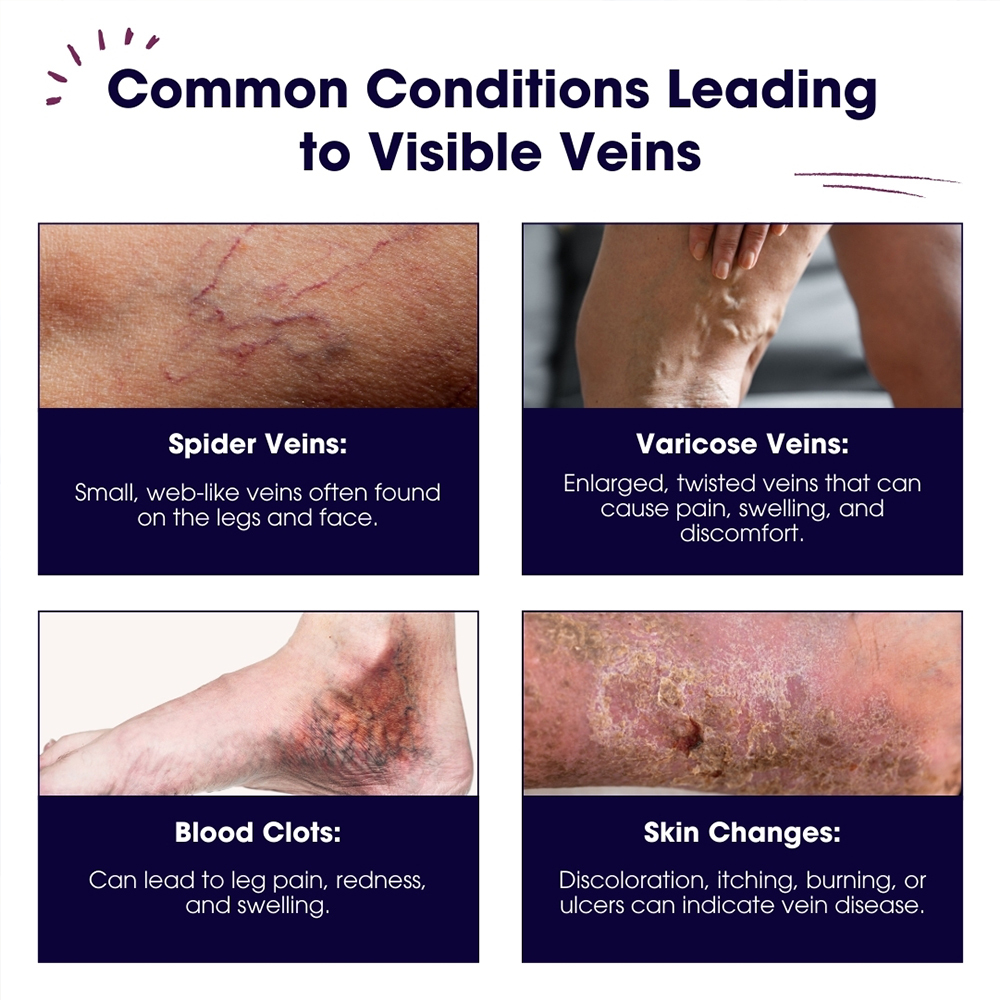Veins showing through your skin or veins that rise above the skin surface can indicate a healthy Body Mass Index (BMI), regular exercise, or even hot weather, but painful or unusual veins should not be ignored. They can be a sign of some undetected health issue and must be carefully examined to avoid long-term complications. Visit Dr. George Bolotin at the Astra Vein Treatment Center to have your veins evaluated for any medical condition and get the best advice on keeping your veins healthy and strong.
If the veins on your legs are becoming more visible, looking darker, or feel raised above the skin, do not take them lightly. Keep an eye on your condition and see if you notice leg swelling, heaviness, achiness, itching, tingling or cramps, or even skin discoloration and ulcers. There may be other causes for visible veins, but sometimes visible veins also result from some underlying vein disease.
Vein diseases often occur when tiny vein valves in the legs fail to function normally and pump the blood back to the heart. It accumulates blood in the veins, leading to varicose veins, spider veins, restless leg syndrome, and other severe health conditions. Varicose veins also increase the risk for blood clots and venous ulcers and should not be disregarded.
What Makes Veins So Visible?
Visible veins can occur anywhere on the body, but the lower extremities are a common sight. If your veins are protruding due to regular training, low body fat, and good muscle, it may be nothing to worry about. However, if painful symptoms accompany your visible veins, they may signify some health problem.
A lot of factors influence overall vein health and visibility. They include:
- Your genetics;
- Lifestyle;
- Environment.
Knowing more about vein health can help you understand the reasons behind your visible veins.

Potential Causes of Visible Veins
Your veins can become prominent for several reasons. They include:
- Exercise: If your veins become visible when you exercise, it is a sign that your cardiovascular system is working effectively. Weight lifting also results in bulging veins as you have a low Body mass index (BMI).
- Skin color: People with fair skin and hair are more likely to have visible veins.
- Age: Skin becomes thin with advancing age, and veins begin to show through the skin. In some cases, body fat loss makes the veins more evident, and they seem closer to the skin surface.
- Obesity: Excessive weight places additional strain on the veins, and it can push the veins out, making them more visible.
- Family history: Research shows if your mother, father, grandparents, or any close blood relation had visible veins, you may also develop them.
- Hormonal changes: Hormonal changes can have a significant impact on vein health. Hormonal imbalance due to pregnancy, menopause, or other health conditions can result in visible veins. Pregnancy leads to increased blood volume that leads to the expansion of blood vessels. This condition usually resolves after giving birth, but medical attention becomes necessary if it does not go away.
- Weather: Veins often become more visible in the summer months. Heat can enlarge the veins and force the vascular system to work harder, making the veins appear even more prominent.
- Long periods of inactivity: Sitting or standing for long hours during the day can cause visible veins.
If your visible veins are due to any other reason, do not waste time in seeking medical advice from a vein specialist. They will determine the causes behind your vein condition and suggest the best treatment options.
Medical Causes of Visible Veins – Conditions You Must Look Out For
Many conditions can lead to visible veins on your hands, legs, feet, or ankles. While their symptoms identify some, others are not easy to determine and require medical evaluation.
Some conditions that lead to visible veins include:
- Spider veins: They are small, blue, green, or purplish-colored veins that mostly appear on the legs and face. They develop in a spider web pattern and cause discoloration or visible veins due to poor circulation in the body.
- Varicose veins: Varicose veins are recognized for their enlarged, bumpy, and extended veins that seem to be rising from the skin surface. If they are not cared for, they can result in significant pain and discomfort. Other symptoms associated with varicose veins include heaviness and swelling in the legs, itching, and burning. Varicose veins result from underlying vein disease or chronic insufficiency.
- Blood clots: Visible veins can be caused by or develop into a blood clot that can be life-threatening if it is not treated timely. An untreated clot can break off and travel up the lungs, causing pulmonary embolism. There are two main types of blood clots, Superficial Thrombophlebitis (ST) and Deep Vein Thrombosis (DVT). Common symptoms experienced in these conditions include leg pain, redness, swelling, tenderness, warmth, and cramping, mostly in one leg.
- Skin changes: You must keep an eye on skin changes as they signify vein disease and lead to severe skin issues. These changes include discoloration, itching, burning, rashes, and venous ulcers. Venous ulcers are open wounds on the legs near varicose veins that take a long time to heal or do not seem to heal at all. These ulcers are a sign of advanced vein disease and increase the risk for skin or blood infections.

Treatment Options for Visible Veins
If you do not like the way your unsightly veins show through the skin or want to remove the pain and discomfort caused by swollen varicose veins, minimally invasive treatment helps you enjoy healthy veins and legs.
Schedule an appointment with your doctor to know why your veins are so visible and what can be done to get them back to normal. Vein diseases can only be treated with proper diagnosis and assessment by a vein specialist doctor.
The experienced and certified vein doctor uses the most advanced diagnostic equipment and multidisciplinary approach to close off malfunctioning veins and reroute blood flow to healthy veins. Most treatments take between 15 to 30 minutes, and you can look forward to getting back into a routine within a few hours.
Visible veins treatment options include:
- Endovenous Laser Treatment (EVLT) – During this procedure, tiny incisions are made in the skin using a small laser fiber catheter. The specialist uses ultrasound to precise position the laser, heated up to close off the diseased vein. EVLT can treat varicose veins of any size that are located close to the surface of the skin.
- ClariVein: ClariVein treats varicose or spider veins without using laser energy. It is a catheter-based treatment that combines mechanical and chemical methods to treat damaged veins.
- Varithena: It is a foam-based treatment designed to treat diseased veins. It is used for collapsing varicose veins in the Great Saphenous Vein (GSV) or the surrounding region.
- Ultrasound-guided sclerotherapy: This procedure seeks help from ultrasound imaging to inject a sclerosant solution into the affected veins. It irritates the vessel walls and collapses, and seals them off. After treatment, the diseased vein tissue is naturally absorbed by the body.
- Visual sclerotherapy: Similar to ultrasound-guided sclerotherapy, it uses sclerosant injections to treat spider veins near the skin’s surface. It has minimal or no side effects.
Depending on the condition of your visible veins and the severity of symptoms, the doctor may develop a customized treatment plan to provide the best care. Dr. George Bolotin offers specialized treatment for protruding veins. He will examine your veins and use ultrasound screening to diagnose your condition and provide relief. Learn more about your vein health and get the most effective solutions to avoid serious vein issues in the long run.
Updated on Jan 13, 2025 by Dr. George Bolotin (Vein & Vascular Specialist) of Vein & Vascular Medical Care
Vein & Vascular Medical Care
4209 Ave U, Suite A.
Brooklyn, NY 11234
(347) 934-9068
Vein & Vascular Medical Care
869 E Tremont Ave
Bronx, NY 10460
(929) 447-4563


